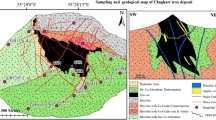Abstract
The study area is located southeast of Dehshir between the Urumieh-Dokhtar Magmatic Arc and Nain-Baft Ophiolite Belt comprising the Nain, Dehshir, Shahr Babak, and Baft ophiolite complexes. The Dehshir Ophiolitic Complex which obducted in the Late Cretaceous, consists mainly of ultramafic rocks. These remnants of oceanic crust are extensively faulted and fractured. The severe faulting and brecciating of the ophiolite sequence have undergone high-grade alteration and changed it to the tectonic mélange. The Dehshir colored mélange is bounded to the west by Dehshir fault which is a right-lateral offset of the Nain-Baft suture. In this research, the petrographic studies of the area showed that the ultramafic rocks consist mainly of dunite and harzburgite intruded by diabasic dikes. Syntectonic hydrothermal fluids circulated throughout these rocks. Migration of Mg-rich fluids and hydrothermal brecciating occurred within highly altered and brecciated zones. Magnesite precipitated from hydrothermal solutions and formed the massive, lenticular, and vein-type ore deposits in serpentinized-hosted rocks. Later on, magnesite turned into hydromagnesite due to hydration at the lower depths near the surface. According to the X-ray diffraction and X-ray fluorescence analysis, hydromagnesite is the most dominant and widely occurring Mg-rich carbonate mineral in this area. The main alteration is serpentinization but birbiritization also occurs as a result of interaction between fluids and ultramafic rocks.







Similar content being viewed by others
References
Adib D, Pamic J (1982) Rodingite form the southeastern part of the Neyriz Ophiolite Complex in the Zagros range Iran, Archive. Sci. Uni, Geneve, pp 281–290
Augustithis SS (1979) Atlas of the textural patterns of basic and ultrabasic rocks and their genetic significance, pp 393
Bashir E, Naseem S, Sheikh S, Kaleem M (2009) Mineralogy of the Kraubath-type magnesite deposits of the Khuzdar area, Balochistan, Pakistan. J Earth Sci Appl Res Cent Hacet Univ 30(3):169–180
Berberian M, King GCP (1981) Toward a paleo-geography and tectonic evolution of Iran. Can J Earth Sci 18:210–265
Ghasemi A, Talbot CJ (2006) A new tectonic scenario for the Sanandaj-Sirjan Zone (Iran). J Asian Earth Sci 26:683–693
Lanphere MA, Pamić J (1983) 40Ar/39Ar Ages and tectonic setting of ophiolite from the Neyriz area, southeast Zagros Range, Iran. Tectonophysics 96(3–4):245–256
Le Maitre RW, Bateman P, Dudek A, Keller J, Lameyre Le Bas MJ, Sabine PA, Schmid R, Sorensen H, Streckeisen A, Woolley AR, Zanettin B (1989) A classification of igneous rocks and glossary of terms. Blackwell, Oxford
Meyer B, Mouthereau F, Lacombe O, Agard P (2006) Evidence of Quaternary activity along the Dehshir Fault: Implication for the Tertiary tectonics of Central Iran. Geophys J Int 164:192–201
Rohgoshay M, Monosef I, Shafaii Moghadam H (2005) Plastic deformation of quartz in quartzite and quartz veins of Khoy ophiolitic massif, NW of Iran. J Earth Sci Tehran Univ 13(1):61–78
Sabzehei M (2002) Rodingitization of Iranian basic rocks, a new interpretation. J Sci Iran 13(2):155–160
Sabzehei M, Nabavi H (1998) Geological map of the Dehshir. Tehran, Geological Survey of Iran, scale 1:100000
Shafaii Moghadam H, Stern RJ (2011) Late Cretaceous forearc ophiolites of Iran. Island Arc, pictorial article no. 20:1–4
Shafaii Moghadam H, Whitechurch H, Rahgoshay M, Monsef I (2009) Significance of Nain-Baft ophiolitic belt (Iran): Short-lived, transtensional Cretaceous back-arc oceanic basins over the Tethyan subduction zone. C R Geosci 49:261–270
Shand AM (2006) The chemistry and Technology of magnesia. John Wiley & Sons, Inc, Hoboken, published simultaneously in Canada
Simandl GJ, Simandl J, Debreceni A (2000) British Columbia hydromagnesite-magnesite Resources: potential flame retardant material. Geol Fieldwork 2001(1):327–336
Weber M (2000) Mineral flame retardants-overview & future trends. Ind Miner 389:19–27
Author information
Authors and Affiliations
Corresponding author
Rights and permissions
About this article
Cite this article
Eslamizadeh, A., Samanirad, S. Petrology of ultramafic rocks and Mg-rich carbonate minerals in southeast of Dehshir, Central Iran. Arab J Geosci 7, 3675–3682 (2014). https://doi.org/10.1007/s12517-013-0953-y
Received:
Accepted:
Published:
Issue Date:
DOI: https://doi.org/10.1007/s12517-013-0953-y




